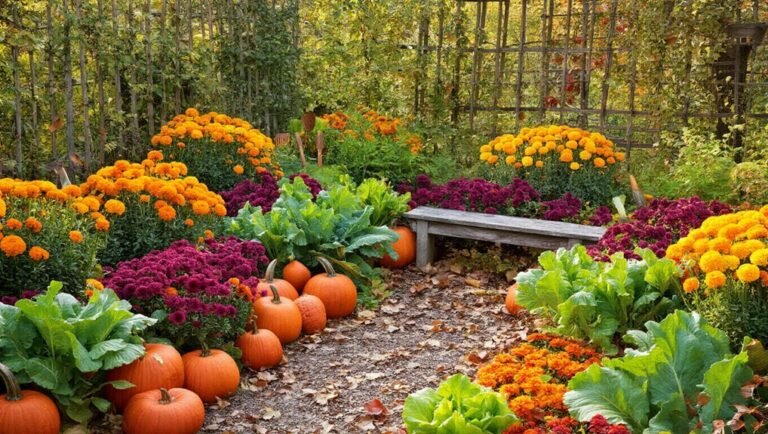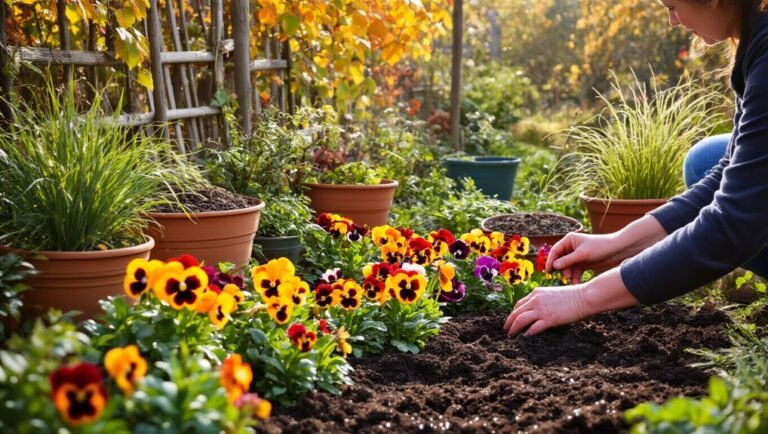If you’re looking to grow sunflowers, start by choosing the right seeds for your space and purpose. Ensure you’ve got ideal planting conditions, like full sun and well-draining soil. Follow a step-by-step guide for planting and caring for your sunflowers, and watch out for common pests and diseases. Once harvested, you can creatively use sunflowers in floral arrangements or as home decor. There’s so much more to discover about these vibrant flowers!
Key Takeaways
- Choose the right sunflower variety based on space, purpose, and local climate for optimal growth and blooming.
- Plant seeds in well-drained soil, 1-2 inches deep, after the last frost, ensuring full sun exposure.
- Water consistently, aiming for about an inch weekly, and mulch to retain moisture and suppress weeds.
- Monitor for pests like aphids and diseases such as downy mildew, using traps and pest control as needed.
- Use sunflowers in floral arrangements, crafts, or as vibrant focal points in garden designs for aesthetic appeal.
Choosing the Right Sunflower Seeds
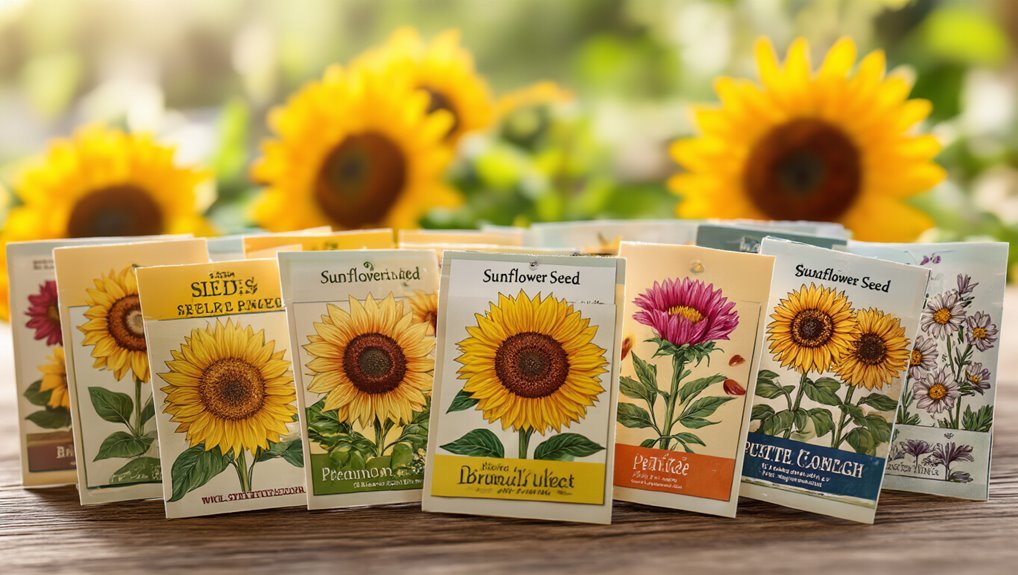
When choosing the right sunflower seeds, how do you know which variety fits your garden best?
Start by considering your space. If you have a small garden, opt for dwarf varieties like “Teddy Bear” that grow under two feet tall. For larger plots, taller types like “Mammoth Grey Stripe” can reach impressive heights and produce large heads. Starting your sunflowers indoors can be made easier and more reliable with seed starting kits designed for optimal germination.
Think about the purpose too—do you want sunflowers for seeds, oil, or just for their beauty? Varieties like “Black Oil” are great for seeds, while “Autumn Beauty” offers stunning colors.
Check the days to maturity to ensure they’ll bloom when you want them. Finally, consider your local climate; some sunflowers thrive in cooler areas, while others prefer warmth.
For the healthiest and most vibrant sunflowers, be sure to plant them in the best garden soil for thriving plants, as this gives them the nutrients and support needed for strong growth.
Ideal Planting Conditions for Sunflowers

To grow healthy and vibrant sunflowers, you need to provide them with the right planting conditions.
Start by selecting a spot that gets full sun; ideally, they should receive at least six to eight hours of direct sunlight daily. Using a garden sprinkler can help ensure your sunflowers receive consistent and even watering, which is especially important during dry periods.
Sunflowers thrive in well-draining soil with a pH between 6.0 and 7.5, so consider testing your soil beforehand. They prefer slightly sandy or loamy textures that offer good drainage.
Make sure the area is sheltered from strong winds, as sunflowers can become top-heavy. Adequate spacing is crucial, too; give them enough room to grow tall and strong.
Lastly, plant your seeds after the last frost to ensure optimal growth during the warm months.
For easy and efficient watering, consider using garden sprayers to deliver moisture directly to the base of your sunflowers and help maintain healthy soil conditions.
Step-by-Step Guide to Planting Sunflowers
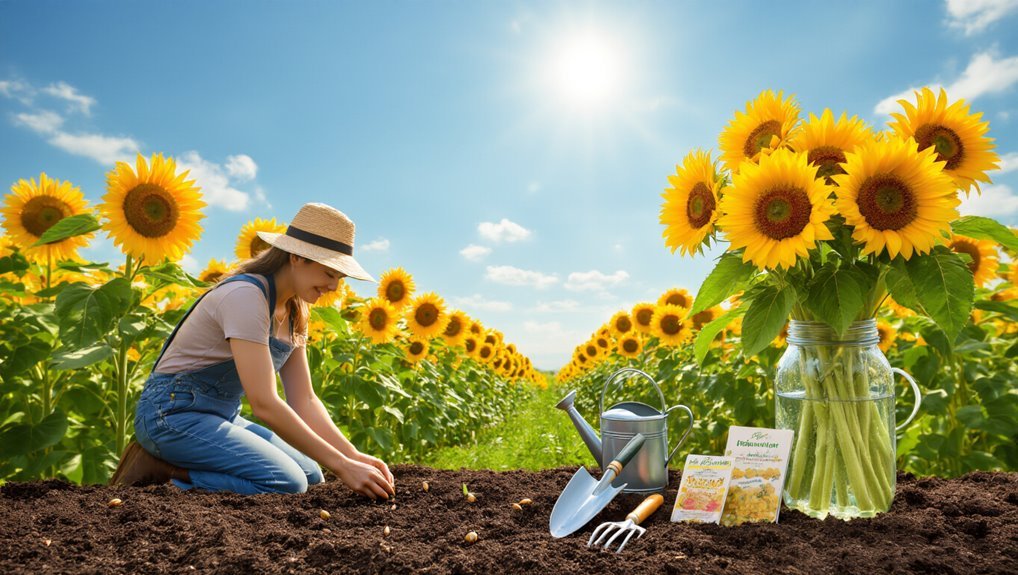
Planting sunflowers is a straightforward process that can yield stunning results in your garden. Start by selecting a sunny spot with well-drained soil. Next, gather your sunflower seeds and prepare the soil by loosening it with a rake. Using the right plant food can significantly improve the health and vigor of your sunflowers throughout the growing season.
| Step | Action |
|---|---|
| 1. | Choose a sunny location |
| 2. | Loosen the soil |
| 3. | Plant seeds 1-2 inches deep |
Space the seeds about 6-12 inches apart. Water gently to keep the soil moist but not soggy. Once seedlings sprout, thin them to ensure ample room for growth. For best results, you can boost your sunflowers’ growth by using plant fertilizer tablets to provide essential nutrients during the growing season. With these simple steps, you’ll soon enjoy vibrant sunflowers in your garden!
Essential Care Tips for Healthy Sunflowers
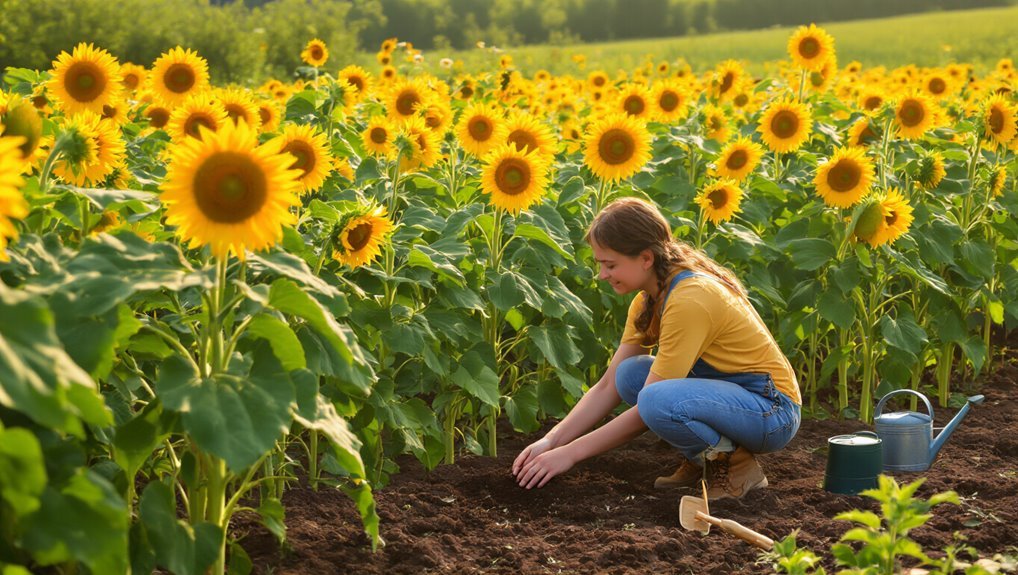
After successfully planting your sunflowers, keeping them healthy is key to enjoying their full beauty.
Start by ensuring they get plenty of sunlight; sunflowers thrive in at least six to eight hours of direct sunlight daily.
Water them consistently, especially during dry spells, aiming for about an inch of water weekly. You should also mulch around the base to retain moisture and suppress weeds. For a natural approach, consider using organic mulching materials such as straw to improve soil health and prevent weed growth.
As they grow, support taller varieties with stakes if needed.
Fertilize with a balanced fertilizer to encourage strong growth, but avoid over-fertilizing, which can lead to weak stems.
Regularly check for any signs of nutrient deficiencies, and adjust your care routine as needed.
With these tips, you’ll have vibrant, healthy sunflowers all season long!
For even better results, consider using the benefits of using mulch to further improve soil moisture, temperature, and weed control in your sunflower garden.
Common Pests and Diseases to Watch For
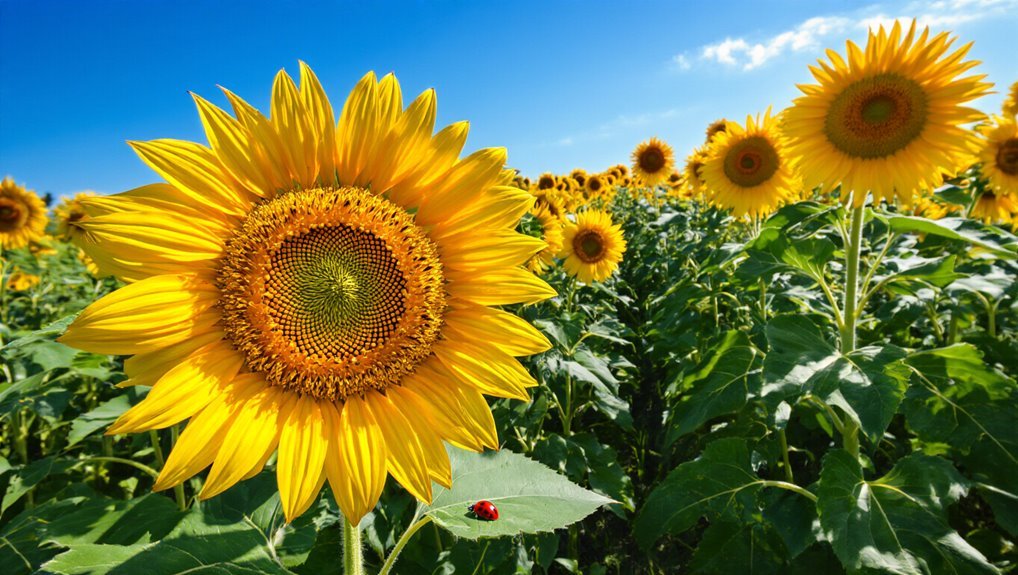
What should you be on the lookout for when caring for your sunflowers? Keeping a close eye on pests and diseases is crucial to ensure your vibrant blooms thrive.
Here are three common culprits that can threaten your sunflowers:
- Aphids: These tiny insects suck sap from your plants, causing wilting and stunted growth. If you see them, act quickly!
- Downy Mildew: This fungal disease appears as yellow spots on leaves, leading to premature leaf drop. It can spread rapidly, so monitor for signs.
- Gray Mold: Often seen in humid conditions, gray mold can ruin your sunflower heads, turning them mushy. Prevent it by ensuring air circulation. Using Garden Pest Traps like sticky traps can also help reduce the number of insect pests before they cause serious harm.
For gardeners facing persistent issues, using effective solutions for pest control can help protect your sunflowers from damage.
Stay vigilant to protect your sunflowers and enjoy their beauty all season long!
Harvesting Sunflowers: When and How
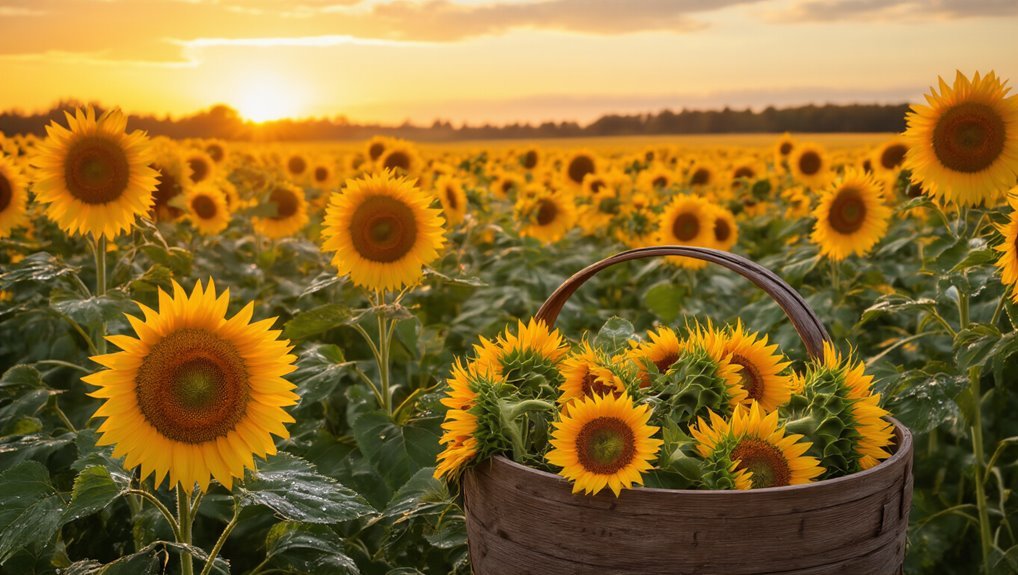
Once you’ve kept your sunflowers healthy by managing pests and diseases, it’s time to think about harvesting.
Look for signs that the seeds have matured; the back of the flower head will turn brown, and the seeds will be plump and dark. This usually occurs about 70-100 days after planting, depending on the variety. For gardeners, having the right garden shovels can also help when loosening soil around heavy sunflower stalks, making harvesting easier.
When the heads are ready, cut the stalk about a foot below the flower. Use pruning shears for a clean cut.
Gardeners often rely on essential pruning shears for precise and effortless harvesting of sunflower stalks.
Hang the heads upside down in a dry, cool location to prevent mold while they finish drying. If you’re harvesting for seeds, check regularly to ensure they’re fully dried before removing them.
Enjoy the fruits of your labor!
Creative Uses for Sunflowers in Your Home
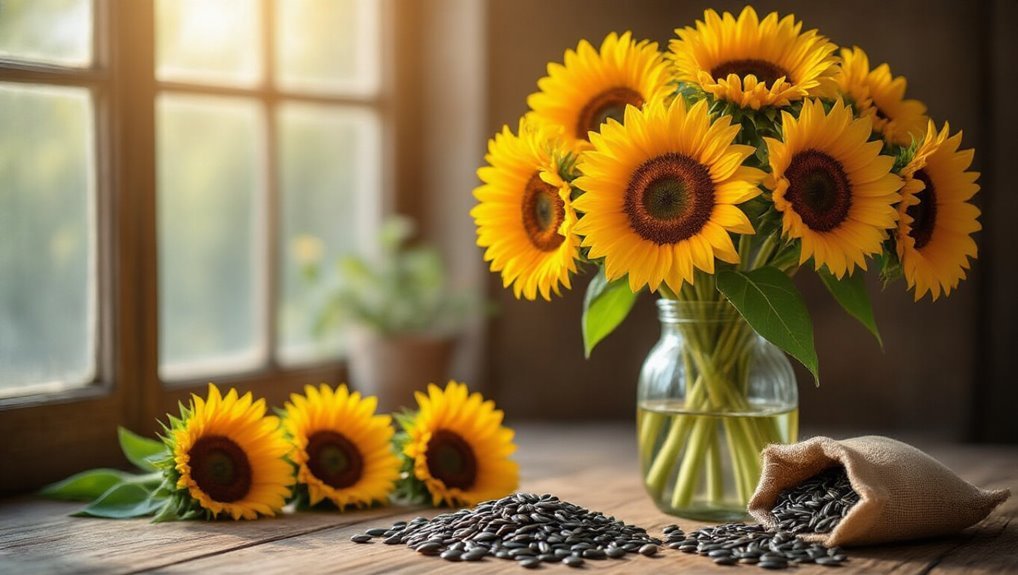
Sunflowers bring a splash of vibrancy and warmth to your home, making them perfect for various creative uses. You can highlight their cheerful presence by displaying them in hanging planters, which add an elegant, modern touch to any interior.
You can transform your space with their cheerful presence in more ways than one. Here are three ideas to inspire you:
- Floral Arrangements: Create stunning centerpieces by combining sunflowers with other seasonal flowers. Their bold colors will brighten any room.
- Wall Art: Press and frame sunflower petals to make unique wall decor. This adds a personal touch and showcases your love for nature.
- DIY Gifts: Craft sunflower-themed gifts, like homemade candles scented with sunflower oil, or create sunflower bookmarks. These personal touches show you care.
For an extra touch, display your sunflowers in beautiful plant pots to further elevate your home’s ambiance and tie your decor together.
Incorporating sunflowers into your home not only enhances your decor but also uplifts your spirit.
Incorporating Sunflowers Into Your Garden Design
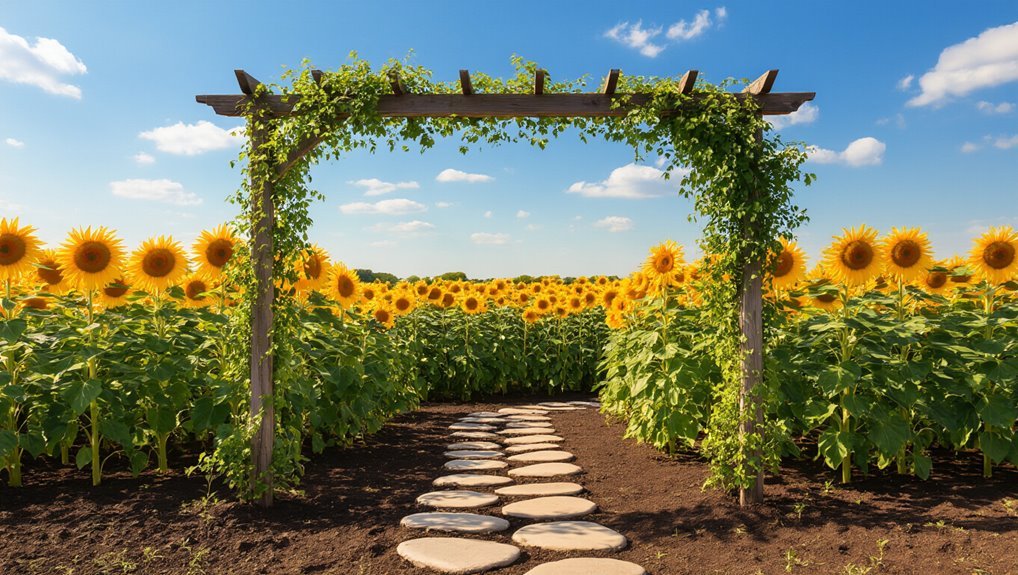
Adding sunflowers to your garden design can create a stunning focal point that draws the eye and brings joy to outdoor spaces. You can plant them in clusters for a dramatic effect or intersperse them among other flowers for a vibrant tapestry of colors.
Consider using shorter varieties at the front of garden beds, while taller ones can stand proudly toward the back, creating depth. Pair sunflowers with complementary plants, like lavender or zinnias, to enhance their beauty. To protect your sunflowers and other delicate blooms, consider using garden netting to shield them from birds and pests.
Don’t forget to think about their orientation—position them where they’ll get full sun to thrive. With a little creativity, sunflowers can transform your garden into a cheerful haven that attracts pollinators and provides a delightful atmosphere for relaxation.
To keep track of your sunflower varieties and planting locations, consider using essential plant markers in your garden.
Fun Facts and Myths About Sunflowers

Ever wondered what makes sunflowers such fascinating plants? These vibrant blooms are steeped in fun facts and myths that’ll amaze you!
Here are three intriguing points you mightn’t know:
- Sunflowers Can Grow Taller Than a House: Some varieties can reach heights of up to 12 feet, making them true giants in your garden.
- They Follow the Sun: Sunflowers exhibit heliotropism, meaning they turn their heads to follow the sun throughout the day—a beautiful dance of nature.
- A Symbol of Loyalty: In many cultures, sunflowers represent adoration and loyalty, making them a perfect gift for loved ones.
Frequently Asked Questions
Can Sunflowers Be Grown in Containers?
Yes, you can grow sunflowers in containers! Just choose a large pot, ensure it has good drainage, and use quality potting soil. Keep them well-watered and place them in a sunny spot for best results.
How Tall Do Different Sunflower Varieties Grow?
Sunflowers, much like towering giants in a fairy tale, can reach impressive heights. Depending on the variety, you’ll find them growing anywhere from 2 to 12 feet tall, each adding its unique charm to your garden.
Are Sunflowers Safe for Pets?
Yes, sunflowers are generally safe for pets. However, it’s best to monitor them, as some pets might chew on the leaves or stems, causing mild stomach upset. Always consult your vet if you’re unsure.
What Is the Best Time of Year to Plant Sunflowers?
When’s the best time to plant sunflowers? You’ll want to sow them in late spring, once the soil warms up. This ensures they thrive and bloom beautifully throughout summer, adding vibrant color to your garden.
Do Sunflowers Attract Beneficial Insects?
Yes, sunflowers attract beneficial insects like bees and butterflies. Their vibrant blooms draw these pollinators, which help your garden thrive. By planting sunflowers, you’re enhancing biodiversity and promoting a healthy ecosystem around your plants.
Conclusion
In the garden of life, sunflowers are like bright beacons, drawing you into their vibrant world. By choosing the right seeds and providing the care they need, you can cultivate these cheerful giants to thrive. Whether you’re using them to beautify your space or enjoying their seeds, sunflowers offer endless joy and creativity. So go ahead—plant your seeds, nurture them, and watch as they bask in the sun, bringing warmth and happiness to your life and garden.
